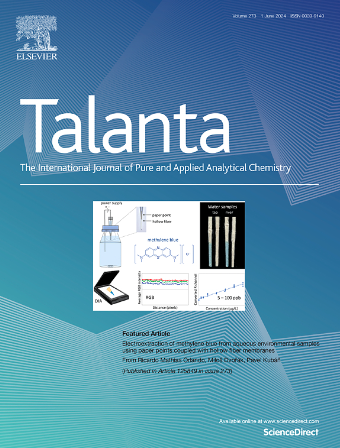Porphyrinic metal-organic framework PCN-224 supported Prussian blue enables selective detection of casein and phytic acid
IF 5.6
1区 化学
Q1 CHEMISTRY, ANALYTICAL
引用次数: 0
Abstract
Monitoring casein and phytic acid content is of great significance for food safety and human health. In this paper, porphyrinic metal-organic framework PCN-224 supported Prussian blue (PCN-224@PB) nanoprobe was constructed by in-situ growth of PB on PCN-224 layer. The supported PCN-224 not only reduces the size and improves the dispersity of PB, but also provides specific affinity for casein and phytic acid. Based on the formation of Zr-OP structure, the peroxidase (POD)-like activity of PCN-224@PB is inhibited when encountering casein. In the presence of phytic acid, the deposited PB is decomposed, thus recovering the fluorescence of PCN-224 quenched by PB. The constructed nanoprobe exhibits high sensitivity with a limit of detection of 0.25 μg/mL for casein and 0.18 μM for phytic acid detection, respectively. In addition, PCN-224@PB shows excellent sensing performance in milk, beverage, corn and cells samples, with casein and phytic acid recoveries ranging from 94.30 % to 103.20 %, further demonstrating its feasibility in real sample analysis.

求助全文
约1分钟内获得全文
求助全文
来源期刊

Talanta
化学-分析化学
CiteScore
12.30
自引率
4.90%
发文量
861
审稿时长
29 days
期刊介绍:
Talanta provides a forum for the publication of original research papers, short communications, and critical reviews in all branches of pure and applied analytical chemistry. Papers are evaluated based on established guidelines, including the fundamental nature of the study, scientific novelty, substantial improvement or advantage over existing technology or methods, and demonstrated analytical applicability. Original research papers on fundamental studies, and on novel sensor and instrumentation developments, are encouraged. Novel or improved applications in areas such as clinical and biological chemistry, environmental analysis, geochemistry, materials science and engineering, and analytical platforms for omics development are welcome.
Analytical performance of methods should be determined, including interference and matrix effects, and methods should be validated by comparison with a standard method, or analysis of a certified reference material. Simple spiking recoveries may not be sufficient. The developed method should especially comprise information on selectivity, sensitivity, detection limits, accuracy, and reliability. However, applying official validation or robustness studies to a routine method or technique does not necessarily constitute novelty. Proper statistical treatment of the data should be provided. Relevant literature should be cited, including related publications by the authors, and authors should discuss how their proposed methodology compares with previously reported methods.
 求助内容:
求助内容: 应助结果提醒方式:
应助结果提醒方式:


